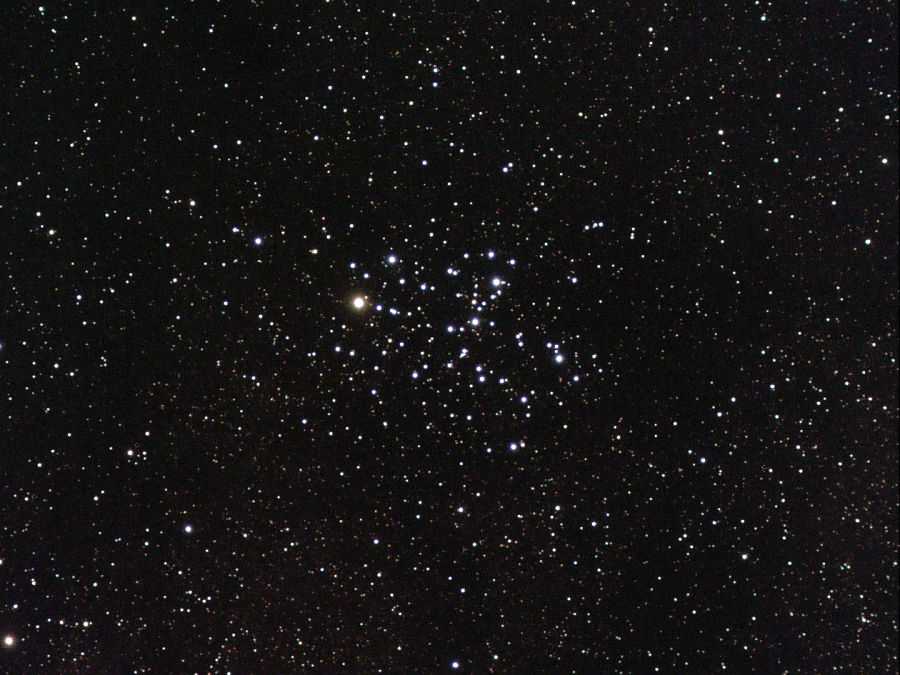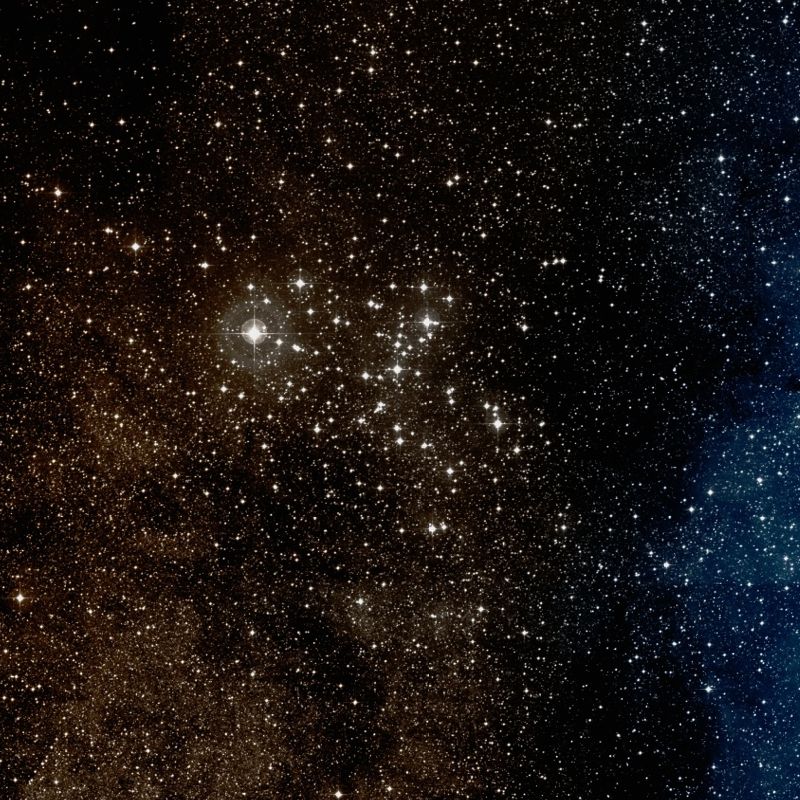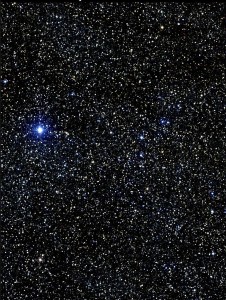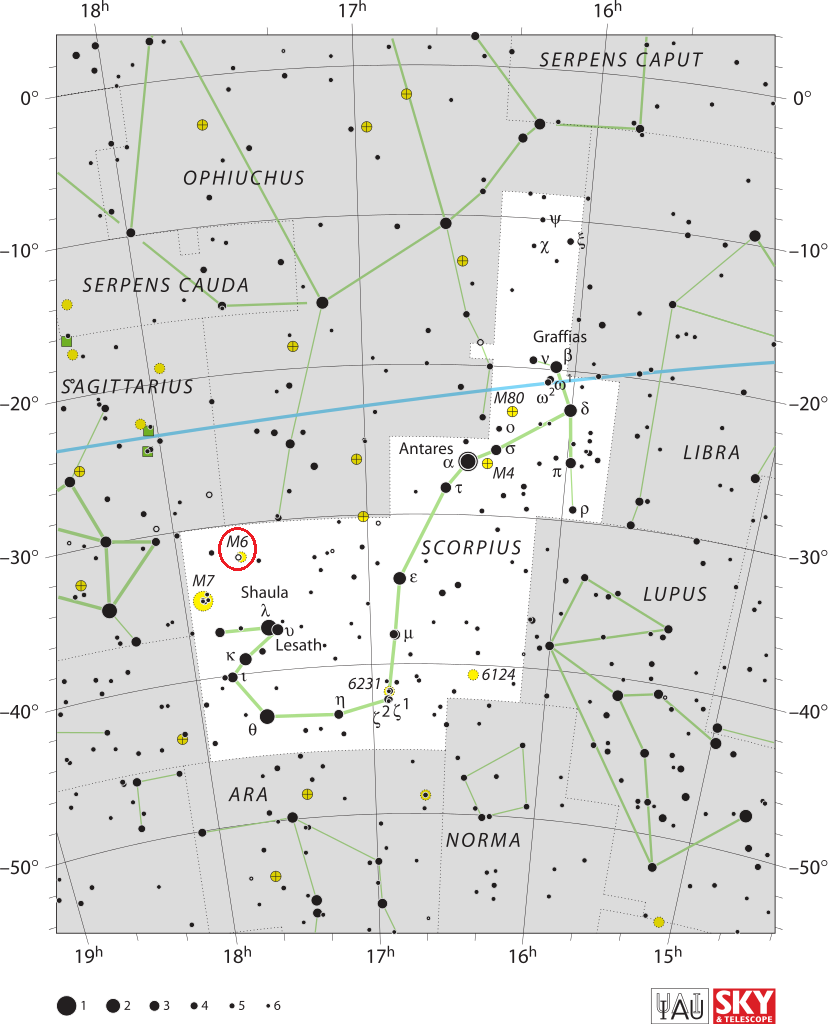Messier 6 (M6), also known as the Butterfly Cluster, is a bright open cluster located in the southern constellation Scorpius. It lies in the direction of the galactic centre, at an approximate distance of 1,600 light years from Earth.
Messier 6 was named the Butterfly Cluster by the American astronomer Robert Burnham, who described it as a “charming group whose arrangement suggests the outline of a butterfly with open wings.” The cluster has an apparent magnitude of 4.2. Its designation in the New General Catalogue is NGC 6405.
Messier 6 is estimated to be around 100,000 million years old. Most of the bright, visible stars in it are hot, young, blue stars belonging to the spectral class B4-B5. However, the brightest star in the cluster is an orange giant belonging to the spectral class K.
The star, BM Scorpii (HD 160371), is a semiregular variable, exhibiting variations in brightness ranging from magnitude 5.5 to magnitude 7. The stars in Messier 6 formed in the same molecular cloud between 51 and 95 years ago and are all moving together through space. They are loosely bound to each other by gravity.

The cluster was discovered by the Italian astronomer Giovanni Battista Hodierna before 1654. It may have been seen by the Greek astronomer Claudius Ptolemy in the 2nd century while he was observing the nearby Messier 7 (Ptolemy Cluster), which lies only five degrees southeast of M6. The Ptolemy Cluster is a significantly brighter and larger open cluster, and it lies much closer to Earth, at 980 light years.
Swiss astronomer Philippe Loys de Chéseaux independently discovered M6 in 1745-46, describing it as “a very fine star cluster.”
Abbé Nicolas Louis de Lacaille, the French astronomer famous for mapping many of the southern constellations, included M6 in his catalogue of 1752 as Lac III.12. Lacaille observed the cluster on June 16, 1752 and described it as a “peculiar cluster of small stars, disposed in three parallel bands, forming a lozenge of 20 to 25 diameter and hitched with nebulosity.”

Charles Messier entered the cluster in his catalogue on May 23, 1764. His entry read, “A cluster of small stars between the bow of Sagittarius & the tail of Scorpius. To the naked eye, this cluster seems to form a nebula without stars; but even with the smallest instrument one employs for investigating one sees a cluster of small [faint] stars. (Diam. 15′)”
The distance, number of stars and other properties of M6 were not measured until the 20th century.
In 1959, Swedish astronomer Ake Wallenquist identified around 80 stars in the cluster, all lying within a region of 54 arc minutes in diameter. The main portion of M6 has an angular diameter of 25 arc minutes, corresponding to about 12 light years in linear diameter.
Messier 6 is best seen in binoculars. Its apparent size is roughly the same as that of the full Moon. The cluster contains more than 300 stars. Binoculars reveal only a few dozen and a small telescope will show about 80 stars brighter than 11th magnitude.

The cluster lies in eastern Scorpius, 5 degrees north and 1.5 degrees east of the multiple star Shaula, or Lambda Scorpii. Shaula is the second brightest star in Scorpius, with a visual magnitude of 1.62, and it marks the scorpion’s stinger with its fainter neighbour Lesath (Upsilon Scorpii). Shaula can be located by following the line of stars that curve from Antares in a southerly direction.
Messier 6, Messier 7 and Shaula form a triangle that can be seen without binoculars to the right of the Teapot asterism in Sagittarius. The Ptolemy Cluster (M7) is the southernmost Messier object in the sky and it lies a little farther to the southeast of M6, closer to the horizon, while the Butterfly Cluster is a bit higher in the sky.
Messier 6 is easy to see without binoculars under good viewing conditions. The butterfly shape appears in 7×50 or 10×50 binoculars, and more stars appear in small telescopes. The contrast between the orange BM Scorpii and other member of the cluster is quite striking.
The best time of year to observe the Butterfly Cluster is in the summer months, when Scorpius appears high in the sky for observers in southern latitudes and is visible above the horizon to observers in the northern hemisphere. M6 is much easier to observe from locations south of the equator because Scorpius never rises high in the sky for northern observers.
Messier 6 lies at a closer angular distance to the galactic centre than any other Messier object. The galactic centre, the rotational centre of the Milky Way, lies in the direction of Sagittarius constellation, near the borders with the constellations Scorpius and Ophiuchus.
FACTS
| Object: Cluster |
| Type: Open |
| Designations: Butterfly Cluster, Messier 6, M6, NGC 6405, Collinder 341, Lund 769, Melotte 178, OCL 1030, ESO 455-SC030, Lac. III.12 |
| Constellation: Scorpius |
| Right ascension: 17h 40.1m |
| Declination: -32°13′ |
| Distance: 1,600 light years (491 parsecs) |
| Age: 100 million years |
| Apparent magnitude: 4.2 |
| Apparent dimensions: 25′ |
| Radius: 6 light years |
LOCATION
